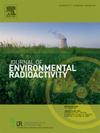有效衰变常数不确定度对CR-39测量介质表面氡析出率的影响
IF 1.9
3区 环境科学与生态学
Q3 ENVIRONMENTAL SCIENCES
引用次数: 0
摘要
CR-39型固体核径迹探测器是一种常用的被动测量氡的仪器。当使用CR-39测量介质表面的氡呼出率时,泄漏的影响往往被忽略。但是,在一定程度上,系统泄漏会影响测量结果的准确性。因此,不同的有效衰变常数(包括泄漏量)对氡呼出速率的影响是值得研究的。本研究采用理论验证和实验验证两种方法,验证了有效衰变常数的不确定度对CR-39测量介质表面氡呼出率结果的影响。在理论验证中,在保持其他变量不变的情况下,将不同的有效衰变常数代入测量氡出气率的CR-39公式中,可以得到不同的氡出气率值。在实验验证中,同时使用CR-39和RAD7测量了同一介质中的氡呼出率。由于传统的被动方法(CR-39固体核径迹探测器)无法直接获得有效衰变常数,因此将CR-39测量实验中的有效衰变常数替换为RAD7实验数据拟合的有效衰变常数值。结果表明,CR-39测得的氡呼出率值远大于RAD7测得的氡呼出率值。理论和实验验证表明,有效衰变常数的不确定度对CR-39测量的氡呼出率有显著影响。本文章由计算机程序翻译,如有差异,请以英文原文为准。

Influence of effective decay constant uncertainty on radon exhalation rate measurement from medium surfaces using CR-39
The CR-39 solid-state nuclear track detector is a commonly used instrument for passively measuring radon. When using CR-39 to measure the radon exhalation rate from the surface of a medium, the effects of leakage are often overlooked. However, to a certain extent, system leakage can affect the accuracy of the measurement results. Therefore, the effect of different effective decay constants (including leakage) on the radon exhalation rate is worth studying. In this study, both theoretical and experimental validation methods were used to verify the effect of the uncertainty of the effective decay constant on the results of CR-39 measurements of radon exhalation rate from the medium surface. In the theoretical validation, different values of radon exhalation rate can be obtained by substituting different effective decay constants into the CR-39 formula for measuring radon exhalation rate while keeping the other variables constant. In the experimental validation, the radon exhalation rate in the same medium was measured using both CR-39 and RAD7. Since the traditional passive method (CR-39 solid-state nuclear track detector) cannot directly obtain the effective decay constant, the effective decay constant in the CR-39 measurement experiment was replaced by the effective decay constant value fitted from the RAD7 experimental data. The results showed that the radon exhalation rate value measured by CR-39 was much larger than that measured by RAD7. From the theoretical and experimental validation, it is concluded that the uncertainty of the effective decay constant has a significant effect on the radon exhalation rate measured by CR-39.
求助全文
通过发布文献求助,成功后即可免费获取论文全文。
去求助
来源期刊

Journal of environmental radioactivity
环境科学-环境科学
CiteScore
4.70
自引率
13.00%
发文量
209
审稿时长
73 days
期刊介绍:
The Journal of Environmental Radioactivity provides a coherent international forum for publication of original research or review papers on any aspect of the occurrence of radioactivity in natural systems.
Relevant subject areas range from applications of environmental radionuclides as mechanistic or timescale tracers of natural processes to assessments of the radioecological or radiological effects of ambient radioactivity. Papers deal with naturally occurring nuclides or with those created and released by man through nuclear weapons manufacture and testing, energy production, fuel-cycle technology, etc. Reports on radioactivity in the oceans, sediments, rivers, lakes, groundwaters, soils, atmosphere and all divisions of the biosphere are welcomed, but these should not simply be of a monitoring nature unless the data are particularly innovative.
 求助内容:
求助内容: 应助结果提醒方式:
应助结果提醒方式:


